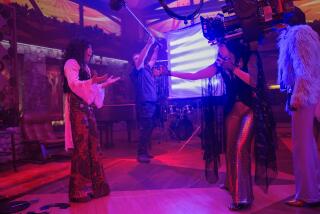AMERICAN ALBUM : Town tries to revive with a little ‘witchcraft’ : 300 years after the hysteria, a commemoration seeks tourist dollars. Events include re-enactment of trials.
- Share via
SALEM, Mass. — On a grassy hill that today overlooks a ball field and tennis court in one of the city’s parks, 19 people were hanged in 1692, falsely accused by their peers of practicing witchcraft.
But no monument and no plaque at “Gallows Hill” recalls the suffering of the victims of Salem’s witchcraft hysteria, or the misdeeds of those who caused it. For three centuries, Salem, despite its claim to the nickname, “Witch City,” has done little to memorialize the events of the shameful episode in its history.
That will soon change. City officials are now planning for a major commemoration in 1992 of the 300th anniversary of the witch trials, which took 23 lives. (In addition to those hanged, a 20th victim was pressed to death with heavy stones beside the city jail and three others died in jail.)
The yearlong witchcraft tercentenary is expected to attract hordes of visitors to this blue-collar city of 38,091, 15 miles north of Boston, whose diverse ethnic groups today live in relative harmony.
City officials do not disguise their hope that anniversary events--including a nationally televised re-enactment of the trials--will be a boon to Salem, which like many older New England cities has been struggling with years of economic decline.
“This gives the opportunity for the city to put on its best face for what we hope will be upwards of a million tourists,” said Mayor Neil J. Harrington, who points to the city’s other attractions, including several major museums, stately old mansions and a historic waterfront.
But whatever benefits the city accrues, tercentenary planners said their primary mission is to educate the public about the events of 1692.
“It’s not a celebration,” said Linda C. McConchie, executive director of the committee planning the event. “It’s really a commemoration to memorialize this period” and to promote tolerance and understanding.
At the least, committee members said they hope to erase some of the misconceptions that have long pervaded popular lore about the hysteria. Among them are that the victims were burned at the stake--they were hanged--and that all were women--there were four men executed.
Robert Sheets, who belongs to the society of descendants of the Rev. George Burroughs, one of the victims of the hysteria, said there is also a popular misconception that those executed practiced witchcraft.
“They were victims of innuendoes, suspicion, hypocrisy and false accusations,” said Sheets, a Denver resident who is writing a book about Burroughs.
The hysteria began in what is now the town of Danvers--then part of Salem--on Feb. 29, 1692, when the first arrests of suspected witches were made, and continued until about Oct. 29, when the court hearing the cases was terminated. Some of the accused remained jailed until May, 1693, when they were pardoned by then-Gov. William Phips.
In all, according to John W. McHale, co-chairman of the anniversary committee, 141 people were accused of witchcraft, 58 indicted and 29 convicted. All 23 who died refused to confess to the false charges.
Organizers said the 300th anniversary events, while recalling the tragedy of the hysteria, will also point to some positive aspects, including the courage displayed by victims.
“If there’s anything to celebrate, that’s it,” said McConchie, of the willingness of 20 accused people to face execution rather than sully their reputations.
City officials said most residents here welcome the attention that will soon be focused on Salem, even if it is based on remembrance of a shameful episode in the city’s past.
“People are not ashamed of their history,” said McHale, though he said some cringe at the “cartoon image” of a witch on a broomstick that can still be found on everything from police cruisers to the city’s daily newspaper.
Still, not everyone is happy about the anniversary plans. A community of modern-day witches in the city has complained that the committee’s work is disparaging them.
Laurie Cabot, a spokeswoman for the witches’ community, which she claims numbers about 2,000 people, contends the committee errs when it persists in using witchcraft as a term for evil or harm rather than a positively oriented earth religion.
The anniversary will likely rekindle debate over what caused the hysteria--theories have ranged from religious conflict to the presence of mold in local grain. But Sheets would like to see the focus placed on commemorating the victims.
“I would hope that Salem could become known as the town where 20 martyrs made history,” he said.
More to Read
Sign up for Essential California
The most important California stories and recommendations in your inbox every morning.
You may occasionally receive promotional content from the Los Angeles Times.










